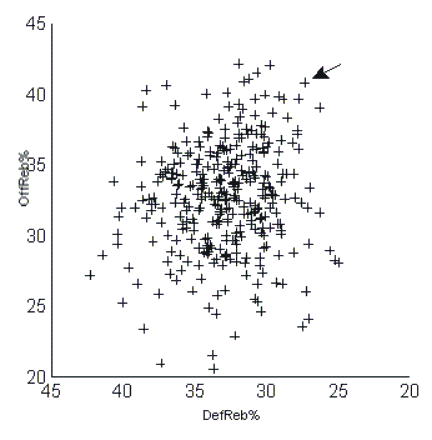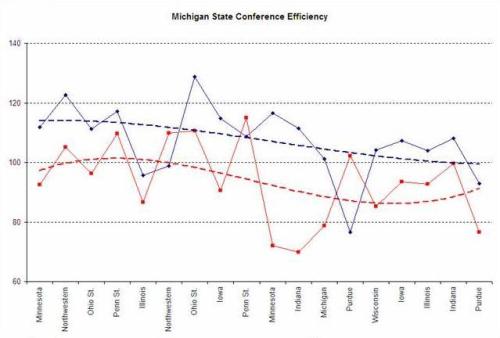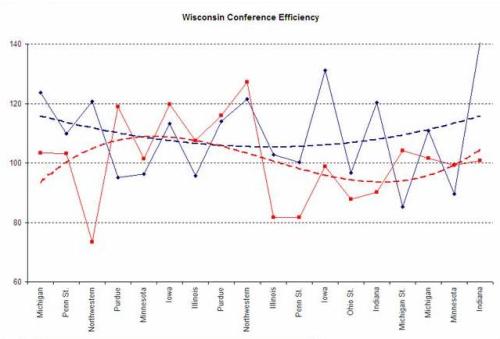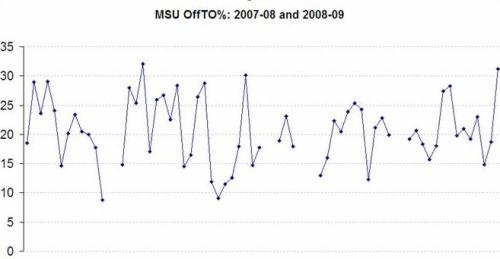A couple months ago, KenPom added something called “defensive fingerprint” on each team page. Mr. Pomeroy’s explanation:
Defensive Fingerprint attempts to objectively identify the style of a team’s defense. Inputs into the system are the departure from the D-1 norm of the following defensive characteristics…
– assist percentage (triple weight, higher means a more likely zone team)
– 3-point attempt percentage (triple weight, higher means a more likely zone team)
– free throw attempt percentage (double weight, higher means a more likely man team)
– turnover percentage (single weight, higher means a more likely man team)
– defensive rebounding percentage (variable weight depending on offensive rebounding percentage, higher means a more likely man team)
All those factors go into a super-secret formula that calculates whether, based on its stats, a given team is likely a zone team or a man-to-man team.
What’s interesting is that, despite the fact that MSU played man-to-man defense for all but a handful of possessions this past season, the formula spits out an “inconclusive” on our team page. To investigate this phenomenon, I’ve put together a table showing MSU’s rankings for the five stats used in the formula. The first set of numbers are the full season; these are the numbers that KenPom is using.
| All Games/National Rank | |||
| MSU Value | MSU Rank | Indicates | |
| Assist % | 52.4 | 131 | Neutral |
| 3PA/FGA | 35.8 | 271 | Zone |
| FTA/FGA | 36.5 | 178 | Neutral |
| TO% | 19.9 | 190 | Neutral |
| Opp OReb% | 27.3 | 11 | Man-to-Man |
You can see why the formula can’t identify us as a man-to-man team. Our opponents shot a lot of 3-pointers, which makes us look like a zone defense. But we ranked 11th nationally in defensive rebounding percentage, which implies that we play man-to-man defense. For the remaining three factors, we’re very near the national averages, so the formula has nothing to go on.
One reading of these numbers is that Tom Izzo’s defensive scheme got the best of both worlds this season:
- By placing in emphasis on preventing dribble penetration by hedging off shooters, the team forced a lot of perimeter shots from its opponents (the primary benefit of a zone defense).
- But the fact the team was fundamentally playing man-to-man defense, particularly on the interior, meant the team didn’t sacrifice anything in terms of defensive rebounding (generally the main weakness of a zone defense).
Before declaring victory in the age-old quest to find the perfect defensive scheme, though, I think we meed to get a little more definition on those three middle-of-the-road formula factors. To do so, I pulled the same numbers for conference games only (with ranks within the Big Ten).
| Conference Games/Rank | |||
| MSU Value | MSU Rank | Indicates | |
| Assist % | 54.2 | 2 | Man-to-Man |
| 3PA/FGA | 32.4 | 9 | Zone |
| FTA/FGA | 34.7 | 7 | Man-to-Man |
| TO% | 20.7 | 8 | Zone |
| Opp OReb% | 24.7 | 1 | Man-to-Man |
For assist percentage and free throw rate, we look more like a man-to-man team. For turnovers, we look more like a zone team.
I’m not sure the low assist percentage is necessarily a major asset or weakness. But the other two numbers are unfavorable. Playing physical man-to-man defense resulted in a relatively higher number of fouls that created additional free throw opportunities for our opponents. At the same time, the fact that our perimeter defenders were more focused on preventing penetration than with disrupting our opponents’ offensive rhythm meant we didn’t create a lot of turnovers.
Overall, then, we had one strength (defensive rebounding) and one weakness (fouling quite a bit) generally associated with man-to-man defense and one strength (forcing perimeter shots) and one weakness (not creating turnovers) generally associated with zone defense.
On net, the way this team played defense obviously worked pretty well, as they finished the season ranked 10th in the country in adjusted defensive efficiency. Most of the numbers above are pretty consistent with the team’s numbers over the past several seasons, indicating that Tom Izzo’s approach to defense hasn’t changed much in recent years. The biggest change from 2007-08 to 2008-09 was an increase in defensive rebounding percentage of roughly 4 percentage points. As one might expect with a Tom Izzo-coached team, the key to success was rebounding.
P.S. You can probably sense I’m stalling for time by throwing a lot of numbers at you. There’s been a bit of a delay in getting the new site launched. It should be ready to go late this week or first thing next week.





You must be logged in to post a comment.